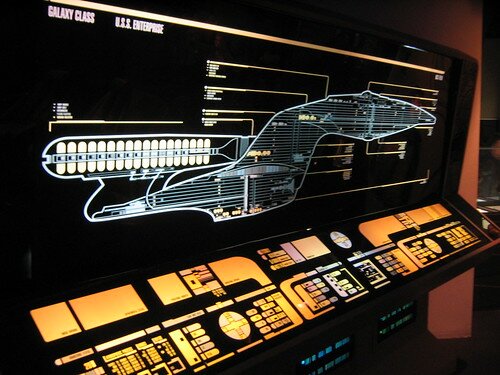FTL stands for faster than light travel. This is one of the standard tropes of science fiction. It may involve warp drive that turns space travel into an analog for ancient sea voyages, or the trip may be instantaneous once you’re far enough from Earth’s surface. However, faster-than-light travel will require the discovery of new laws of physics that may not exist. This leaves us with the other options for traveling in a universe without FTL.
Generation Ships
This concept has existed for decades, but it has become less common in modern stories. Star Trek and Star Wars probably had an impact in that regard. Another recent factor may be the shifting ethical landscape, the idea that it is immoral to commit your children to living in a metal can hurtling through space. This isn’t an issue if you’re truly escaping Earth. Post-apocalyptic disasters like the backstory of Serenity or Exit Earth make it moral to condemn your children to the regimented life of the generation ship because it is the only way to live. Religious and cultural groups fleeing for their literal survival would be another case. That was presented years ago in Robert Heinlein’s Methuselah’s Children and Orphans of the Sky.
One interesting argument against generation ships is that once you can sustain a large group of people indefinitely inside the craft, you have no need for planets. You could simply build many habitats in space, each tailored to human needs and desires. There is no need to travel interstellar distances unless the solar system itself is lost. And in a solar system populated with thousands of habitats, you could simply move them further out as the sun expanded. Or they could navigate the Oort Belt before moving into deep space. For them, it isn’t a generation ship but a craft moving on in search of additional resources or generally exploring. This premise was hinted at in Icehenge, but the focus of that novel was the failed rebellion on Mars and cripplingly oppressive society that followed.
Sleeper Ship
The sleeper ship has been explored in science fiction for generations, and it even made an appearance in sixth season of The 100. Go to sleep, wake up in another solar system years later. It allows those who started the journey to finish it, though it raises the risk they’ll die in transit. The early colony ships in Larry Niven’s Known Universe offset the risks of having everyone asleep by having a few officers awake at a time to keep an eye on things.
Sleepers use far fewer resources than active crew. This allows you to have a much smaller craft plus their supplies. A side benefit of that is the fact that you could accelerate much faster and arrive sooner than the average generation ship. If the destination turns out to be inhospitable, the crew might or might not be able to return home, but you didn’t waste thousands of lives in the process of getting there. Depending on the design, they may be able to move on to the next potential target or return to Earth.
Artificial Intelligence
Advances in technology are raising the possibility that artificial intelligence and humanity will explore the cosmos hand in hand. OK, circuit in circuit and pattern in pattern. If we can actually upload human minds to the cloud and store them, you could download human explorers into robotic bodies to explore alien worlds. You could in theory get post-human colonists on alien worlds. If we can actually replicate human bodies, colonists could download into new bodies if the world was amenable to it.
The Green Leopard Plague and Other Stories by Walter Jon Williams features several variations of this in the same anthology. You could send sleepers who awaken, terraform and colonize, and they could summon digitally broadcast additional colonists who only show up when things are ready. Or you can upload personalities and body specs to a database and send an AI laden ship at a fraction of the speed of light to a destination. Maybe the personalities wake up every few light-minutes to check email and keep in touch with family left behind. Or they sleep the whole way. They could entertain themselves, too. If they have to return to Earth, they’re free to download into new bodies and update themselves as appropriate.
Another version of this was fleshed out in Arthur C. Clarke’s book The Songs of Distant Earth. You send exploratory ships to other solar systems. If they’re habitable, they become seedships, replicating the next generation of humanity on an alien world. It raises the children in a crèche and trains them how to survive on the world. If the world is inhospitable, no lives are lost. If the world is friendly, the ship could restart the human race even if Earth was lost in the process. And the technology involved in this isn’t as far fetched as uploading your brain to a starship and hoping you can faithfully replicate yourself on the download, too. Instead, it requires artificial wombs (that we’re working on) and computers that can actually teach kids everything they need to live. And starships that travel at a fraction of the speed of light.
*****
Photo by alistairmcmillan 



Comments
Leave a Reply